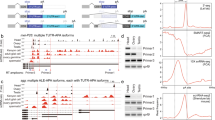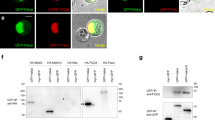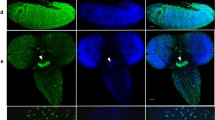Abstract
Members of the Hedgehog (Hh) family of signaling proteins are powerful regulators of developmental processes in many organisms and have been implicated in many human disease states. Here we report the results of a genome-wide RNA interference screen in Drosophila melanogaster cells for new components of the Hh signaling pathway. The screen identified hundreds of potential new regulators of Hh signaling, including many large protein complexes with pleiotropic effects, such as the coat protein complex I (COPI) complex, the ribosome and the proteasome. We identified the multimeric protein phosphatase 2A (PP2A) and two new kinases, the D. melanogaster orthologs of the vertebrate PITSLRE and cyclin-dependent kinase-9 (CDK9) kinases, as Hh regulators. We also identified a large group of constitutive and alternative splicing factors, two nucleoporins involved in mRNA export and several RNA-regulatory proteins as potent regulators of Hh signal transduction, indicating that splicing regulation and mRNA transport have a previously unrecognized role in Hh signaling. Finally, we showed that several of these genes have conserved roles in mammalian Hh signaling.
This is a preview of subscription content, access via your institution
Access options
Subscribe to this journal
Receive 12 print issues and online access
$209.00 per year
only $17.42 per issue
Buy this article
- Purchase on Springer Link
- Instant access to full article PDF
Prices may be subject to local taxes which are calculated during checkout






Similar content being viewed by others
References
Ogden, S.K., Ascano, M. Jr., Stegman, M.A. & Robbins, D.J. Regulation of Hedgehog signaling: a complex story. Biochem. Pharmacol. 67, 805–814 (2004).
Nybakken, K. & Perrimon, N. Hedgehog signal transduction: recent findings. Curr. Opin. Genet. Dev. 12, 503–511 (2002).
Lum, L. & Beachy, P.A. The Hedgehog response network: sensors, switches, and routers. Science 304, 1755–1759 (2004).
Mello, C.C. & Conte, D., Jr. Revealing the world of RNA interference. Nature 431, 338–342 (2004).
Boutros, M. et al. Genome-wide RNAi analysis of growth and viability in Drosophila cells. Science 303, 832–835 (2004).
Cherry, S. et al. Genome-wide RNAi screen reveals a specific sensitivity of IRES-containing RNA viruses to host translation inhibition. Genes Dev. 19, 445–452 (2005).
Foley, E. & O'Farrell, P.H. Functional dissection of an innate immune response by a genome-wide RNAi screen. PLoS Biol. 2, E203 (2004).
Kiger, A.A. et al. A functional genomic analysis of cell morphology using RNA interference. J. Biol. 2, 27 (2003).
Lum, L. et al. Identification of Hedgehog pathway components by RNAi in Drosophila cultured cells. Science 299, 2039–2045 (2003).
Chen, C.H. et al. Nuclear trafficking of Cubitus interruptus in the transcriptional regulation of Hedgehog target gene expression. Cell 98, 305–316 (1999).
DasGupta, R., Kaykas, A., Moon, R.T. & Perrimon, N. Functional genomic analysis of the Wnt-wingless signaling pathway. Science 308, 826–833 (2005).
Lejeune, F. & Maquat, L.E. Mechanistic links between nonsense-mediated mRNA decay and pre-mRNA splicing in mammalian cells. Curr. Opin. Cell Biol. 17, 309–315 (2005).
Pyronnet, S., Pradayrol, L. & Sonenberg, N. Alternative splicing facilitates internal ribosome entry on the ornithine decarboxylase mRNA. Cell. Mol. Life Sci. 62, 1267–1274 (2005).
Noureddine, M.A., Donaldson, T.D., Thacker, S.A. & Duronio, R.J. Drosophila Roc1a encodes a RING-H2 protein with a unique function in processing the Hh signal transducer Ci by the SCF E3 ubiquitin ligase. Dev. Cell 2, 757–770 (2002).
Ou, C.Y., Lin, Y.F., Chen, Y.J. & Chien, C.T. Distinct protein degradation mechanisms mediated by Cul1 and Cul3 controlling Ci stability in Drosophila eye development. Genes Dev. 16, 2403–2414 (2002).
Jiang, J. & Struhl, G. Regulation of the Hedgehog and Wingless signalling pathways by the F-box/WD40-repeat protein Slimb. Nature 391, 493–496 (1998).
Deshaies, R.J. SCF and Cullin/Ring H2-based ubiquitin ligases. Annu. Rev. Cell Dev. Biol. 15, 435–467 (1999).
de Falco, G. & Giordano, A. CDK9 (PITALRE): a multifunctional cdc2-related kinase. J. Cell. Physiol. 177, 501–506 (1998).
De Luca, A., De Falco, M., Baldi, A. & Paggi, M.G. Cyclin T: three forms for different roles in physiological and pathological functions. J. Cell. Physiol. 194, 101–107 (2003).
Garriga, J. & Grana, X. Cellular control of gene expression by T-type cyclin/CDK9 complexes. Gene 337, 15–23 (2004).
Hu, D., Mayeda, A., Trembley, J.H., Lahti, J.M. & Kidd, V.J. CDK11 complexes promote pre-mRNA splicing. J. Biol. Chem. 278, 8623–8629 (2003).
Lahti, J.M., Xiang, J. & Kidd, V.J. The PITSLRE protein kinase family. Prog. Cell Cycle Res. 1, 329–338 (1995).
Trembley, J.H. et al. PITSLRE p110 protein kinases associate with transcription complexes and affect their activity. J. Biol. Chem. 277, 2589–2596 (2002).
Zhang, K., Smouse, D. & Perrimon, N. The crooked neck gene of Drosophila contains a motif found in a family of yeast cell cycle genes. Genes Dev. 5, 1080–1091 (1991).
Raisin-Tani, S. & Leopold, P. Drosophila crooked-neck protein co-fractionates in a multiprotein complex with splicing factors. Biochem. Biophys. Res. Commun. 296, 288–292 (2002).
Chung, S., McLean, M.R. & Rymond, B.C. Yeast ortholog of the Drosophila crooked neck protein promotes spliceosome assembly through stable U4/U6.U5 snRNP addition. RNA 5, 1042–1054 (1999).
Park, J.W., Parisky, K., Celotto, A.M., Reenan, R.A. & Graveley, B.R. Identification of alternative splicing regulators by RNA interference in Drosophila. Proc. Natl. Acad. Sci. USA 101, 15974–15979 (2004).
Burnette, J.M., Hatton, A.R. & Lopez, A.J. Trans-acting factors required for inclusion of regulated exons in the Ultrabithorax mRNAs of Drosophila melanogaster. Genetics 151, 1517–1529 (1999).
Black, D.L. Mechanisms of alternative pre-messenger RNA splicing. Annu. Rev. Biochem. 72, 291–336 (2003).
Hastings, M.L. & Krainer, A.R. Pre-mRNA splicing in the new millennium. Curr. Opin. Cell Biol. 13, 302–309 (2001).
Kelley, R.L. Initial organization of the Drosophila dorsoventral axis depends on an RNA-binding protein encoded by the squid gene. Genes Dev. 7, 948–960 (1993).
Lall, S. et al. Squid hnRNP protein promotes apical cytoplasmic transport and localization of Drosophila pair-rule transcripts. Cell 98, 171–180 (1999).
Barnard, D.C., Ryan, K., Manley, J.L. & Richter, J.D. Symplekin and xGLD-2 are required for CPEB-mediated cytoplasmic polyadenylation. Cell 119, 641–651 (2004).
Bastos, R., Lin, A., Enarson, M. & Burke, B. Targeting and function in mRNA export of nuclear pore complex protein Nup153. J. Cell Biol. 134, 1141–1156 (1996).
Powers, M.A., Forbes, D.J., Dahlberg, J.E. & Lund, E. The vertebrate GLFG nucleoporin, Nup98, is an essential component of multiple RNA export pathways. J. Cell Biol. 136, 241–250 (1997).
Ullman, K.S., Shah, S., Powers, M.A. & Forbes, D.J. The nucleoporin nup153 plays a critical role in multiple types of nuclear export. Mol. Biol. Cell 10, 649–664 (1999).
Therond, P.P., Knight, J.D., Kornberg, T.B. & Bishop, J.M. Phosphorylation of the fused protein kinase in response to signaling from hedgehog. Proc. Natl. Acad. Sci. USA 93, 4224–4228 (1996).
Robbins, D.J. et al. Hedgehog elicits signal transduction by means of a large complex containing the kinesin-related protein costal2. Cell 90, 225–234 (1997).
Wang, Q.T. & Holmgren, R.A. The subcellular localization and activity of Drosophila cubitus interruptus are regulated at multiple levels. Development 126, 5097–5106 (1999).
Nybakken, K.E., Turck, C.W., Robbins, D.J. & Bishop, J.M. Hedgehog-stimulated phosphorylation of the kinesin-related protein Costal2 is mediated by the serine/threonine kinase fused. J. Biol. Chem. 277, 24638–24647 (2002).
Price, M.A. & Kalderon, D. Proteolysis of the Hedgehog signaling effector Cubitus interruptus requires phosphorylation by Glycogen Synthase Kinase 3 and Casein Kinase 1. Cell 108, 823–835 (2002).
Denef, N., Neubuser, D., Perez, L. & Cohen, S.M. Hedgehog induces opposite changes in turnover and subcellular localization of patched and smoothened. Cell 102, 521–531 (2000).
Jia, J. et al. Shaggy/GSK3 antagonizes Hedgehog signalling by regulating Cubitus interruptus. Nature 416, 548–552 (2002).
Janssens, V. & Goris, J. Protein phosphatase 2A: a highly regulated family of serine/threonine phosphatases implicated in cell growth and signalling. Biochem. J. 353, 417–439 (2001).
Randsholt, N.B., Maschat, F. & Santamaria, P. Polyhomeotic controls engrailed expression and the hedgehog signaling pathway in imaginal discs. Mech. Dev. 95, 89–99 (2000).
Collins, R.T. & Cohen, S.M. A genetic screen in Drosophila for identifying novel components of the hedgehog signaling pathway. Genetics 170, 173–184 (2005).
Bond, B.J. & Davidson, N. The Drosophila melanogaster actin 5C gene uses two transcription initiation sites and three polyadenylation sites to express multiple mRNA species. Mol. Cell. Biol. 6, 2080–2088 (1986).
Taylor, F.R. et al. Enhanced potency of human Sonic hedgehog by hydrophobic modification. Biochemistry 40, 4359–4371 (2001).
Ascano, M. Jr., Nybakken, K.E., Sosinski, J., Stegman, M.A. & Robbins, D.J. The carboxyl-terminal domain of the protein kinase fused can function as a dominant inhibitor of hedgehog signaling. Mol. Cell. Biol. 22, 1555–1566 (2002).
Acknowledgements
We thank R. Dasgupta, S. Armknecht, K. Kerr, S. Talala, J. Murphy, I. Flockhart, M. Booker, N. Ramadan, B. Mathey-Prevot and the entire staff of the Drosophila RNAi Screening Center at Harvard Medical School for assistance throughout the project; the Harvard Institute of Chemistry and Cell Biology screening center and its staff for use of equipment and advice; A. Kiger, M. Boutros and the Heidelberg Screening Consortium for their work in establishing the dsRNA collection; K. Richards, K. Kerr, L. Hrdlicka and C. Villalta for technical assistance; P. Bradley, H. Agaisse, R. Zhou and the rest of the Perrimon lab for advice; P. Beachy for the ptcΔ136 reporter construct; T. Kornberg and P. Aza-Blanc for the Hh and Ci plasmids; and P. Wolfe for assistance in identifying mammalian orthologs. This work was supported in part by a National Institutes of Health postdoctoral fellowship (K.N.), the Howard Hughes Medical Institute (N.P.), National Institutes of Health grants (T.-Y.L., N.P. and A.P.M.) and the Helen Hay Whitney Foundation (S.A.V.).
Author information
Authors and Affiliations
Corresponding authors
Ethics declarations
Competing interests
A.P.M. is a patent holder on licensed Hedgehog-related technologies and has stock options in Curis Corp., a biotechnology company pursuing the Hedgehog pathway.
Supplementary information
Supplementary Fig. 1
Secondary assays. (PDF 116 kb)
Supplementary Fig. 2
Phosphorylation of Fu and Cos2 are not affected by reduction in Cdk9, Pitslre, or mts. (PDF 133 kb)
Supplementary Table 1
Potential positive regulators of Hh signaling. (PDF 159 kb)
Supplementary Table 2
Potential negative regulators of Hh signaling. (PDF 103 kb)
Supplementary Table 3
Orthologs of potential Hh regulators. (PDF 141 kb)
Supplementary Table 4
Summary information and scores for genes tested in secondary assays. (PDF 225 kb)
Rights and permissions
About this article
Cite this article
Nybakken, K., Vokes, S., Lin, TY. et al. A genome-wide RNA interference screen in Drosophila melanogaster cells for new components of the Hh signaling pathway. Nat Genet 37, 1323–1332 (2005). https://doi.org/10.1038/ng1682
Received:
Accepted:
Published:
Issue Date:
DOI: https://doi.org/10.1038/ng1682
This article is cited by
-
The emerging roles of phosphatases in Hedgehog pathway
Cell Communication and Signaling (2017)
-
Coupling optogenetics and light-sheet microscopy, a method to study Wnt signaling during embryogenesis
Scientific Reports (2017)
-
A cell based, high throughput assay for quantitative analysis of Hedgehog pathway activation using a Smoothened activation sensor
Scientific Reports (2017)
-
Smoothened regulation in response to Hedgehog stimulation
Frontiers in Biology (2015)
-
CHK2 kinase promotes pre-mRNA splicing via phosphorylating CDK11p110
Oncogene (2014)



